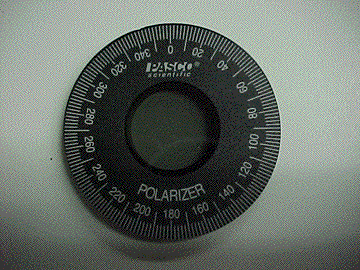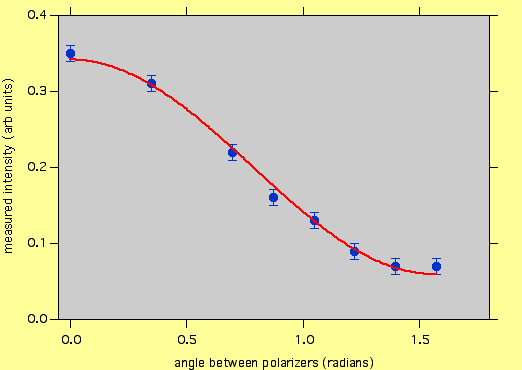
Malus' Law of
Polarization
[ HomePage | Experiments
| Equipment | Data
Analysis | Software | Techniques
]
Overview:
Suppose that unpolarized light is incident on two linear
polarizers. The angle between the polarizers is 
and the intensity of the incident light is Io. The
intensity of the light leaving the two polarizers is given by Malus'
law:

The factor of 1/2 in the above equation comes about because the
incident light is unpolarized. Malus' law demonstrates that there is
a vector field, the E field, associated with light - an
electromagnetic wave.
Goal of this Experiment:
Use the PASCO equipment to measure the dependence of transmitted
intensity as a function of the angle between the two polarizers. A
simple schematic of the setup to be used is shown below.

The calibrated polarizers (shown below) should be mounted in
placeholders.

Suggested Procedures:
- Set up the apparatus with no polarizers in place. Measure the
intensity of light.
- Use a single polarizer and now measure the intensity of light.
Is the light intensity reduced by a factor of 2? Is this result
independent of the orientation of the polarizer?
- Replace the polarizer used in the previous step with the
polarizer. Do you get the same results?
- Now make measurements with both polarizers in place. Make
meaurements for various angles between the two polarizers.
Sample Data:
The plot below shows data taken with the setup of this experiment.
The data displayed here were fit to a function of the form:


Questions:
- What is your estimate of the error in measuring the intensity
of the light with no polarizers? With a single polarizer? With two
polarizers? Explain how you arrive at your answers and
measurements you make to back up your estimates.
- The polarizers are calibrated. How accurate are the degree
scales on the polarizers? Can you think of any way to check
this?
- What is your estimate of the error in the angle between the
two polarizers?
- In the above analysis, what is the physical significance of
the two constants, a and b?
- Can you think of ways to reduce the constant a?
- With respect to all the measurements you make in this
experiment - would the use of apertures at the light source or
before the fiber (or both) help? Describe any measurements you
make to answer this question.
- With respect to all the measurements you make in this
experiment - would it help to use lenses to focus the light?
Describe any measurements you make to answer this question.
![]()


